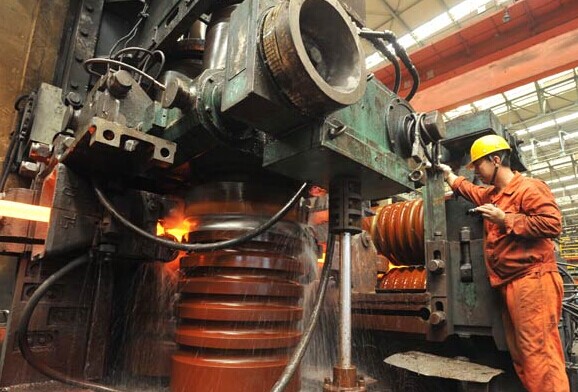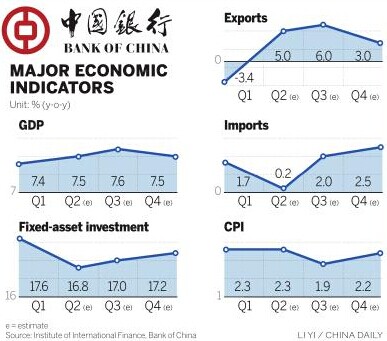

An employee works at a rod machine at a special steel plant in Dalian, Liaoning province. Although economic growth has stabilized, downward pressures still remain, said a Bank of China report.LIU DEBIN/CHINA DAILY

Strategic sectors to benefit from govt measures to boost expansion
Fiscal policy is expected to play a larger role in supporting second-half GDP growth, while the scope of "targeted" monetary easing may expand, Bank of China Ltd's research unit said in a report on Wednesday.
The report, released by the Institute of International Finance, said that although growth in recent months has stabilized, downward pressure has persisted, so more supportive policies are needed.
Fiscal policy could play a broader role, with larger expenditures and a wider deficit, the report said. More money should be spent on railway construction in inland regions, urban renovation, energy efficiency and urban infrastructure, which would translate into higher investment growth.
The government would also further ease companies' tax burdens and allow more cities to make independent issues of municipal bonds, the report said.
"The fiscal deficit was 2.2 percent in 2013. It could be higher this year, as long as it doesn't exceed 3 percent, an international warning level," said Zhou Jingtong, a senior researcher at the institute.
Shenyin & Wanguo Securities Co Ltd and China Minzu Securities Co Ltd have also forecast increased fiscal expenditure, specifically on infrastructure, in the second half.
Fixed-asset investment growth in May did not deteriorate much despite slumping real estate investment growth, mainly because of accelerated infrastructure spending.
Infrastructure investment in the first five months rose 25 percent year-on-year, 2.2 percentage points faster than in the first four months, according to the National Bureau of Statistics.
On the monetary policy front, BOC forecast more "targeted easing" toward sectors that are regarded as "strategically emerging industries" such as renewable energy and alternative-fuel vehicles.
The next cut in the reserve requirement ratio-the amount of money banks are required to set aside-could also be larger than the most recent trim.
To spur lending to agriculture and small businesses, the central bank in early June cut the reserve requirement ratio by 0.5 percentage point for commercial banks that have extended a certain portion of their loans to agriculture and small businesses.
The cut applied to two-thirds of city commercial banks, 80 percent of rural commercial banks below the county level and 90 percent of cooperative banks below the county level, according to the People's Bank of China.
Zhou said the banks that are eligible for the ratio cut could extend into more joint-stock banks.
The central bank last week also revised the way loan-to-deposit ratios are calculated to give banks more capacity to lend. BOC said the calculation could be further adjusted within certain sectors to encourage lending to "strategically emerging industries".
More proactive monetary and fiscal policies, however, should not be construed as a way to drive the economy into high gear but to ensure growth within "a reasonable range", the report said.
It estimated 7.5 percent GDP growth for the second quarter.
Looking ahead, it forecast 7.6 percent for the third quarter and 7.5 percent for the whole year.
China will release second-quarter GDP figures on July 16. Institutions' projections range from 7.3 percent to 7.5 percent.
Property cooldown not fatal to GDP
The property sector is important to China's economy, but perhaps not as important as some might think.
A study by the Institute of International Finance under Bank of China Ltd noted that since 2009, the sector's contribution to GDP has steadily declined.
Since China privatized its urban property sector in 1998, its contribution to GDP has gone from 4.2 percent in 1999 to 16.4 percent in 2009.
But the ratio has declined since 2010, when the central government took measures to cool the market and rein in soaring prices. Its contribution to GDP that year fell to 10.6 percent and in 2012 to 9.3 percent, but it rebounded in 2013 to 10.7 percent due to an extraordinary boom that year.
The study predicted that China's property investment will rise by 15 percent this year, but the sector will drag down GDP growth by only 0.33 percentage point, a figure that shouldn't scare the public.
Even in the gloomiest projection, showing property investment growth sinking to 10 percent, GDP would be dragged down by only 0.62 percentage point.
But this scenario is unlikely to occur, the report said, because the government has ample capacity to cushion a slowdown-for example, by building more government-subsidized housing and rolling out more projects backed by budgeted funds.
China eyes modern fiscal system
2014-07-01RRR cut releases liquidity of $5.28 billion to market
2014-06-17RRR cut won‘t aid property market
2014-06-11Copyright ©1999-2018
Chinanews.com. All rights reserved.
Reproduction in whole or in part without permission is prohibited.